Homosexuality
Brotherhoods of Warriors
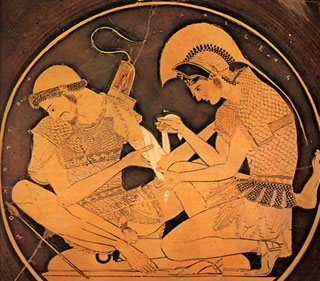 "The community of their lives had brought about profound friendship among these men. The camp, for
most, took the place of their country; living without a family they transferred the needful tenderness
to a companion, and they would fall asleep in the starlight side by side under the same cloak. And
then in their perpetual wanderings through all sorts of countries, murders, and adventures, they
contracted affections, one for the other, in which the stronger protected the younger in the midst
of battles, helped him to cross precipices, sponged the sweat of fevers from his brow, and stole
food for him, and the weaker, a child perhaps, who had been picked up on the roadside, and had
then become a Mercenary, repaid this devotion by a thousand kindnesses."
(Gustave Flaubert: Salammbô).
"The community of their lives had brought about profound friendship among these men. The camp, for
most, took the place of their country; living without a family they transferred the needful tenderness
to a companion, and they would fall asleep in the starlight side by side under the same cloak. And
then in their perpetual wanderings through all sorts of countries, murders, and adventures, they
contracted affections, one for the other, in which the stronger protected the younger in the midst
of battles, helped him to cross precipices, sponged the sweat of fevers from his brow, and stole
food for him, and the weaker, a child perhaps, who had been picked up on the roadside, and had
then become a Mercenary, repaid this devotion by a thousand kindnesses."
(Gustave Flaubert: Salammbô).
Though Flaubert pictures here the relations of the warriors during the great Mercenary War in Carthage (241-238 BC) after the First Punic War, he was obviously more influenced by Greek sources, and contemporary events in the French military. Nevertheless I'm convinced that such relations between warriors were never better described than in this fictional novel. On the other hand there aren't any confessions of homosexual mercenaries. One finds traces in court records, and even though one can discover accounts by mercenaries, they are of course always about others. Nevertheless, there is enough evidence to see that, although often concealed, homosexuality runs like a golden thread through the history of mercenaries.
When this subject comes up it is often argued that such practices occurred because mercenaries were forced to live without women, and hasty parallels to "prison gays" are constructed. But the matter isn't so simple. In ancient Greece pederasty was a widely accepted practice which wasn't considered in opposition to any military, i.e. manly, qualities. On the contrary, it was apparently most common amongst the martial Spartans. Love between men for the Greeks was something that connected warriors and distinguished them, like the mythical relationship between Achilles and Patroclus or the 150 couples of the Theban city guard, who fell side by side in the battle of Chaeroneia in 338 BC.
The problem was merely the passive part of the relationship, which was regarded as effeminate and thus unwarlike. Although this role was normally assumed by youngsters who were not yet counted as "real men", it was still considered derogatory. As a result, anal intercourse was to be avoided at least in theory. Not affected by this restriction, of course, were slaves and prisoners of war. Each hoplite had a slave as a servant in the field and Xenophon reports that the mercenaries took boys as bounty in Persia.
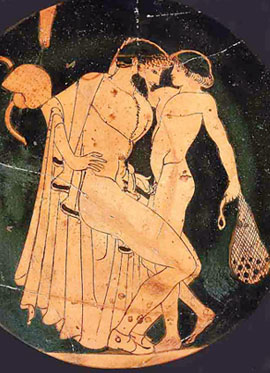 In the Roman Republic pederasty was even prohibited by law. But this too referred only to the passive role
in relations among free citizens - slaves didn't count. Nevertheless, these laws were quickly outrun by
reality. In Rome, homosexual relationships were quite common; there were masses of male prostitutes who
legally paid their taxes, and many rich and powerful men spent fortunes on their male lovers. According
to Edward Gibbon, Claudius was the only one of the first fifteen emperors who had no homosexual inclinations,
and among Caesar's legionaries salacious jokes circulated, because in his relationship with Nicomedes of
Bithynia he was believed to have been the passive one.
In the Roman Republic pederasty was even prohibited by law. But this too referred only to the passive role
in relations among free citizens - slaves didn't count. Nevertheless, these laws were quickly outrun by
reality. In Rome, homosexual relationships were quite common; there were masses of male prostitutes who
legally paid their taxes, and many rich and powerful men spent fortunes on their male lovers. According
to Edward Gibbon, Claudius was the only one of the first fifteen emperors who had no homosexual inclinations,
and among Caesar's legionaries salacious jokes circulated, because in his relationship with Nicomedes of
Bithynia he was believed to have been the passive one.
From ancient to modern times there were always authors who interpreted homosexuality as a typical symptom of decadence. Recent studies, however, see it as something archetypal, the heritage of ancient Indo-European initiation rites. Even at the time, the Celtic warrior aristocracy, famous for its ferocity, were known by the Greeks and Romans to have preferred the sexual company of men. The Greeks even claimed that the Celts sometimes slept with two boys simultaneously.
And what about the Germanic tribes? In this case, there is a repeatedly cited passage from Tacitus, which stated that homosexuals had been drowned in swamps. One might doubt this evidence due to the fact that Tacitus primarily wanted to use the example of some "noble savages" to show his own society, which he perceived as decadent, the fate that awaited those who indulged in such behavior. But even if this cruel justice was applied, it is now mostly accepted that the victims were also passive homosexuals.
In many Germanic tribes later-born sons, who were not entitled to inherit, were organised into warrior societies. These brotherhoods were strictly separated from the rest of society, and surrounded by an aura of mystery. From their ranks came the dreaded warriors who dressed in wolf or bear skins and transformed, with the help of shamanic rites, into raging beasts. Normally these warrior groups lived by hunting and robbing, and were always first to sign up and lead in wars or raids. Not only was contact with women forbidden, but almost everything that was redolent of such contact was despised as effeminate and unwarlike.
In this thoroughly masculine atmosphere the accusation of homosexuality was one of the gravest insults, one which could be expiated only by death. However, the insult referred exclusively to the passive role; active partners in contrast - as in many modern macho societies - counted as "real men". Furthermore in Nordic sagas this insult is so common that a modern historian pointed out with good reason that the affront only made sense if everybody knew what was going on.
It is generally assumed that in these brotherhoods of warriors the young novices - the beardless - had to take the passive role until they became full-fledged warriors themselves, by killing dangerous animals or proving themselves in battle. As has been already mentioned, this represents the remains of ancient initiation rites, whose roots can be traced back to the migration period of the Indo-European peoples. There are hints and traces of such behavior in Hittite mythology, in Celtic and Germanic tribes, as well as among the Greeks and Romans.
But I think that's not all by far. Pederasty as an established institution can be found in such remote warrior societies as the Japanese samurai, the Turkish Janissaries and the Egyptian Mamluks. Again and again one comes across the almost "classical" relationship between experienced warriors and "beardless" - the preferred word for novices. But even if these warrior societies were newly formed without much tradition, homosexuality often seems to be a defining moment, as recent studies of North African corsairs, or the pirates of the Caribbean Sea, show.
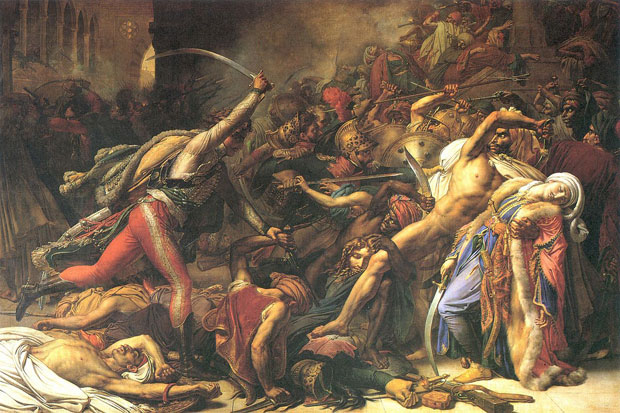
With the Middle Ages, the Christian Church started its relentless persecution of "sodomy" and the last remnants of pagan rites. But the church made slow progress and it seems that homosexuality throughout the Middle Ages was more ignored and disregarded than persecuted. Among the medieval English kings, William Rufus, Richard the Lionheart and Edward II were all probably homosexual or bisexual. There was talked about and some chroniclers made allusions but nobody pressed charges. It seems that the primary result of moral pressure from the church was that existing realities were concealed and ignored. Only when the French king needed a good excuse for the disbandment of the Templars did sodomy become useful as a reason for persecution. That changed with the 16th Century, when Catholics and Protestants competed for being the most zealous in burning heretics, witches, and of course homosexuals. At the same time, the founding of standing armies allowed for stronger enforcement of internal discipline.
The brutal punishments which were in use occasionally at this time served more to preserve appearances, but changed little about the reality of soldiers' daily life. During a campaign it was normal for two men to share a straw hut or a tent. Until the 19th Century it was also common practice that two soldiers slept in one bed when billeted in towns and villages. In colonial service, where soldiers sometimes lived together for years in small, remote outposts, they developed close ties which certainly often went beyond mere "companionship". The widespread practice of making each other heirs is certainly no evidence of homosexuality, but is a further indication of the closeness of these relationships. Although from the 16th Century on there are more reports that mercenaries were burned for sodomy, there are also accounts that in emergency situations when every man was needed, the death penalty was waived. One can assume that many officers turned a blind eye, especially if they themselves had had similar experiences.
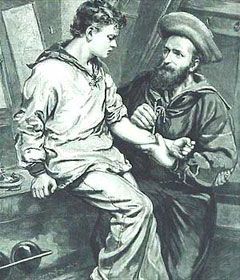 The problem was alleviated only when many soldiers brought women with them. But not all soldiers could afford a
woman, and from the end of the 16th Century army reformers made huge attempts to reduce the enormous baggage train
and all its attendant followers. However, it is significant that many reports of sodomy refer to isolated garrisons
or to the lowest - i.e. the poorest - levels of military hierarchy. So it is mentioned in several sources that the
soldiers in the besieged Candia (1648-1669) "were horribly devoted to sodomy." A German officer of the French garrison
in Corfu says that the impoverished people sold their daughters for a few piasters to the foreign officers, but he
also mentions that the penniless mercenaries often had homosexual relationships.
The problem was alleviated only when many soldiers brought women with them. But not all soldiers could afford a
woman, and from the end of the 16th Century army reformers made huge attempts to reduce the enormous baggage train
and all its attendant followers. However, it is significant that many reports of sodomy refer to isolated garrisons
or to the lowest - i.e. the poorest - levels of military hierarchy. So it is mentioned in several sources that the
soldiers in the besieged Candia (1648-1669) "were horribly devoted to sodomy." A German officer of the French garrison
in Corfu says that the impoverished people sold their daughters for a few piasters to the foreign officers, but he
also mentions that the penniless mercenaries often had homosexual relationships.
Nowhere was this forced deprivation of female companionship more strongly felt than at sea, and it is not surprising therefore that most of the information is to be found in naval accounts. Sodomy is mentioned in almost all of the numerous travelogues of mercenaries in the service of the Dutch VOC. Although cabin boys were often involved - one account tells of a cabin boy who was only eleven years old - not much effort was made to investigate the circumstances surrounding such liasons. Those caught were bound indiscriminately or stuffed in a sack and thrown into the sea. If a port was near the instigator was burned and the others drowned. When those of a higher status were involved, such as officers or captains, they received the grace of being strangled before the burning. The frequent accounts of underage cabin boys suggests the involvement of violence and extortion.
Digging a little deeper, one discovers that homosexuality was so widespread in the Foreign Legion that the Arabs talked of "Madame Legion". Since the administration wouldn't forego a single legionnaire, there was not only no punishment, but homosexuals from other units were often put into the Foreign Legion as a kind of disciplinary action. The main reason for homosexuality among the Foreign Legion was certainly the lack of women; because the reputation of the legionnaires differed only slightly from that of convicts, they were shunned by normal women like the plague. There were always prostitutes of course, but even the cheapest were mostly unaffordable for these men. Especially in the remote outposts and lonely desert forts, young recruits became easy prey for the "anciens". But more established couples were not uncommon in Algeria. There were even officers who had their batmen sleeping in their tent with them.
 Philip Rosenthal, who served in the Foreign Legion during the Second World War, wrote about the prevalence
of homosexuality quite frankly. He says that in the Legion the practice was "less a hidden vice but much
more a public nuisance, which often kept me from sleeping in the barracks." Most explicit, however, is
the Swiss writer Friedrich Glauser, who served for some years in the Foreign Legion and wrote of his
experiences in his semi biographical novel Gourrama (1940).
Philip Rosenthal, who served in the Foreign Legion during the Second World War, wrote about the prevalence
of homosexuality quite frankly. He says that in the Legion the practice was "less a hidden vice but much
more a public nuisance, which often kept me from sleeping in the barracks." Most explicit, however, is
the Swiss writer Friedrich Glauser, who served for some years in the Foreign Legion and wrote of his
experiences in his semi biographical novel Gourrama (1940).
In discussing homosexuality in the Foreign Legion parallels are often drawn to prison sexuality which of course is for the most part accurate. But the more outspoken reports of the 20th Century in particular reveal some of the latent homosexuality present in this climate of extreme masculinity.
It should also be noted that some historians explain the widespread homosexuality in classical Greece by noting the extremely low level of education among women, assuming that men felt bored to tears in female company. However, nowadays the educational level of many women is undoubtedly much higher than that of an average mercenary. Also, more than in other social circles, in the military the sexes can seem more than a little alien to each other, with incomprehension on both sides. A good example of this is the investigation by Professor Sandra Whitworth into the initiation rites of Canadian paratroopers. An even better insight into this testosterone-fuelled atmosphere, replete with tests of courage, body worship, fellowship and latent homosexuality, is provided by the French movie "Beau Travail" (1999).
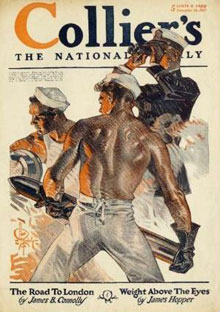 Most soldiers vehemently oppose such insinuations of course. However, this didn't stop the Pentagon
requesting in the 1990s several million dollars for the development of a so-called "gay-bomb". With
this bomb strong aphrodisiacs were to be sprayed over enemy lines, in the hopes that their fighting
strength would drained in a homosexual orgy. Although this patently absurd project was quickly
cancelled, it nevertheless demonstrates what behavior generals expect soldiers to be capable of,
once the control barriers are lowered even slightly.
Most soldiers vehemently oppose such insinuations of course. However, this didn't stop the Pentagon
requesting in the 1990s several million dollars for the development of a so-called "gay-bomb". With
this bomb strong aphrodisiacs were to be sprayed over enemy lines, in the hopes that their fighting
strength would drained in a homosexual orgy. Although this patently absurd project was quickly
cancelled, it nevertheless demonstrates what behavior generals expect soldiers to be capable of,
once the control barriers are lowered even slightly.
Further Reading
Blomberg, Catharina: The Heart of the Warrior: Origins and Religious Background of the Samurai System in Feudal Japan (1994)
Boswell, John: Christianity, Social Tolerance, and Homosexuality (1980)
Bremmer, Jan: An enigmatic Indo-European Rite: Paederasty In: Arethusa 13 (1980) p.279-298
Burg: Sodomy and the Pirate Tradition (1995)
Burgwinkle, William E.: Sodomy, Masculinity and Law in Medieval Literature: France and England, 1050-1230 (2004)
Feijoo, Ramiro: Corsarios Berberiscos (2003)
Gade, Kari Ellen: Homosexuality and Rape of Males in Old Norse Law and Literature (1986)
Jochens, Jenny: Old Norse Magic and Gender. Scandinavian Studies 63.3 (1991)
Jochens, Jenny: Reprentations of Skalds in the Sagas 2: Gender Relations (2001)
Murray, Stephen O. and Will Roscoe (Ed.): Islamic Homosexualities: Culture, History, and Literature (1997)
Percy, William Armstrong: Pederasty and Pedagogy in Archaic Greece (1996)
Whitworth, Sandra: Men, Militarism and Unpeacekeeping: A Gendered Analysis (2004)